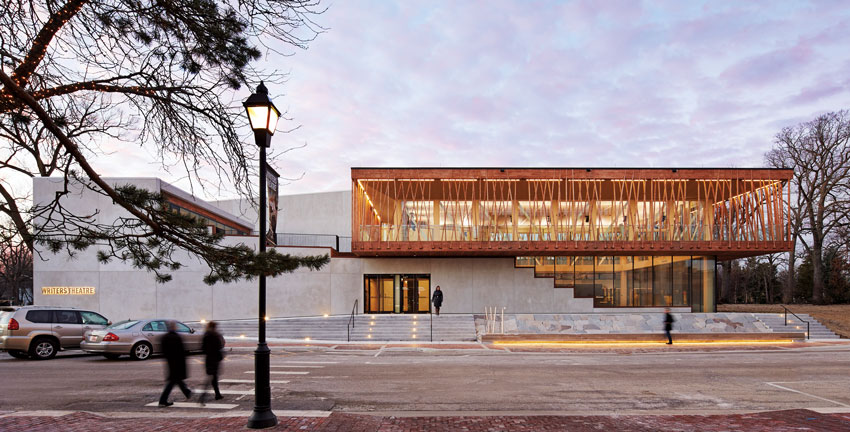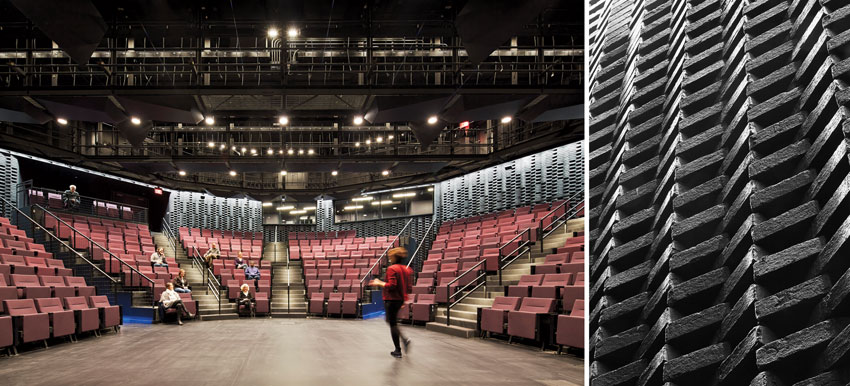Acoustics
Learning Objectives:
- Describe acoustical strategies for making a large space feel intimate.
- Describe strategies for optimizing acoustics in spaces intended for diverse uses.
- Describe acoustical strategies for mitigating mechanical noise and noise from outside a space.
- Define such terms as reverberation time, sound-transmission class, and noise-reduction coefficient.
Credits:
This course is approved as a core course
View course on architecturalrecord.com »
Humans are visual creatures, and architects are particularly visual humans—first the drawings and then the photographs are often mistaken for a building’s whole story. But the experience of architecture is more powerful and subtle than eyes alone perceive. Especially in community gathering places, acoustics play a vital role in shaping a building’s character and the quality of experience it facilitates. From theater to library to ashram, designers are working with acoustics to bring their projects into the round.


PHOTOGRAPHY: © STEVE HALL/HEDRICH BLESSING
ADAPTIVE REUSE
The main performance space at Studio Gang’s Writers Theater (top) in Glencoe, Illinois, includes an acoustic screen made of bricks (bottom) salvaged from the company’s former home.
Few buildings are designed for acoustics more deliberately than performance spaces, as Chicago-based Studio Gang’s new Writers Theatre illustrates. The 36,000-square-foot building comprises two performance spaces (a main stage and a smaller black-box venue) opening onto a glass lobby structured by timber trusses. Located in Glencoe, Illinois, and completed in 2016, the new theater replaces a much smaller-capacity venue in which Writers grew up. Theatrical intimacy has characterized the spoken-word company since its start in 1992, and the design team strove to maintain that quality even as Nichols Theatre, Writers’ new 250-seat main stage, more than doubled the capacity of the previous venue and quadrupled its acoustic volume.
The spatial design fosters intimacy using a thrust stage around which the audience is seated, with no edge or change of level to separate the front row from the performance. But the acoustics for Writers’ typically unamplified performances presented a complex challenge in the larger room. The human auditory system measures the volume of a space by subconsciously comparing the difference between the time direct sound arrives along the line of sight and the time reflected sound arrives from the space’s perimeter surfaces. The farther away these surfaces are from the listener, the later their reflections arrive; the later the reflections, the more degraded the sense of acoustic intimacy. “In acoustic terms, a fourfold increase is vast,” says Carl Giegold, a partner with Threshold Acoustics, Chicago-based consultants to the project.
Threshold uses the metaphor of storytelling around a forest campfire to describe its solution for creating the feeling of being close to or alone with performers, even with more distant surfaces. The actors onstage represent the light, heat, and story around which the audience gathers; unlike the walls of a room, the boundary of a forest clearing—tree trunks and canopy—is diffuse and vague. Translating this experience into built form, the design surrounds the audience with a diffusive screen. Bricks salvaged from the facade of Writers’ previous home (a 1938 structure demolished to make way for the new building) are offset 8 inches from the primary theater’s perimeter walls. They form a highly articulated surface that changes in shape and amplitude as it rises from floor to catwalk. “The complex patterning of the screen mimics the randomness of the outdoor environment,” says Giegold, “and defeats the acoustic boundaries of the room.”
Importantly, the brick screen does not absorb the sound; instead, it breaks sound waves into random energy. “We kept that energy in the room,” says Giegold. “We diffused it and sent it back to envelop the audience in an ambience rather than in a series of hard reflections.” While the sound continues to infuse the theater with energy, it no longer betrays its size.
Having dealt with undesirable reflections from distant surfaces, the designers then set about further enhancing intimacy by introducing a few deliberately distinct reflections from spots near the actors. Small but critically placed and shaped reflectors are located on the underside of the catwalks, and a couple of sail-like reflectors are suspended between them. These take the sound on stage and throw it across the room, so that an actor speaking with his or her back to one side of the audience is nonetheless intelligible. “We end up with a distinctive, intimate character that is the hallmark aesthetic of Writers Theatre,” says Juliane Wolf, a design principal at Studio Gang.
While a theater needs as blank an acoustic slate as possible, libraries’ acoustic needs are increasingly various. The Old Galt Post Office Idea Exchange in Cambridge, Ontario, by Toronto-based RDHA, and the new Central Library in Austin, Texas, by San Antonio–based Lake|Flato and Boston-based Shepley Bulfinch, represent a new breed of library: they are intended as dynamic, polyvalent gathering places. With spaces that can accommodate diverse programming, they address more challenging acoustic issues than libraries have historically faced.










